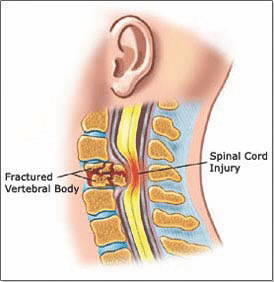By Dr Shane Drakes
 Let us look this week at spinal cord injury (SCI) and rehabilitation.
Let us look this week at spinal cord injury (SCI) and rehabilitation.
Firstly, what is the spinal cord? It is a cylindrical bundle of nerves and supporting tissues connecting the brain to the rest of the body. It transmits electrical signals from the brain to the rest of the body. These electrical signals include motor information travelling from the brain to the limbs and trunk so we can move and sensory information from the body to the brain so we can appreciate touch, temperature and pain among other sensations. This allows us to respond to stimuli from inside or outside our bodies. The spinal cord is protected by our vertebrae (spinal bones). Damage to the nerves in the spinal cord prevents the transmission of signals through the damaged area in either direction.
A spinal cord injury can be caused by trauma (accidents, falls, assault) or non-traumatic causes such as spinal arthritis, infection, tumors, blood vessel damage or radiation. Motor vehicle accidents are the most common cause of SCI, followed by falls, acts of violence (most commonly gunshots) and sports injuries (most commonly diving). Traumatic SCI most commonly occurs in young males between 15 and 35 years of age. In persons over 60 years of age, falls are the most common cause of SCI.
 Symptoms after a spinal cord injury include weakness/inability to move the limbs, altered or no sensation, bowel and bladder problems, spasticity (increased muscle tone) and sexual dysfunction. The presence and severity of symptoms will depend on the level at which the spinal cord is damaged and the completeness of the injury. The primary component of the injury (damage to the nerves and blood vessels of the cord) occurs at the time of the initial trauma. The secondary component of the injury includes inflammation, altered blood flow and release of dangerous chemicals. This occurs later and causes further tissue damage.
Symptoms after a spinal cord injury include weakness/inability to move the limbs, altered or no sensation, bowel and bladder problems, spasticity (increased muscle tone) and sexual dysfunction. The presence and severity of symptoms will depend on the level at which the spinal cord is damaged and the completeness of the injury. The primary component of the injury (damage to the nerves and blood vessels of the cord) occurs at the time of the initial trauma. The secondary component of the injury includes inflammation, altered blood flow and release of dangerous chemicals. This occurs later and causes further tissue damage.
 SCI is associated with complications involving every organ system. Harmful effects of this multisystem involvement include:
SCI is associated with complications involving every organ system. Harmful effects of this multisystem involvement include:
- Breathing difficulty which may require ventilator use in those with high level neck injuries
- Pneumonia
- Urinary tract infections
- Constipation
- Low blood pressure, decreased fitness and coronary artery disease
- Osteoporosis
- Change in body composition predisposing the individual to diabetes and high cholesterol
- Pain from overuse of the arms in wheelchair users
- Sexual dysfunction and decreased fertility in males
How can a physiatrist help persons who suffered spinal cord injury? After medical and possibly surgical treatment after the injury, intensive interdisciplinary rehabilitation is needed to maximize physical function. The team will need to include physical and occupational therapists, nursing staff, social workers and vocational therapists. The physiatrist can coordinate the rehabilitation process and educate the patient and family about potential medical complications and how these can be avoided and managed. During rehabilitation , the patients will begin to learn routines that they will likely have to perform for the rest of their lives. These include management of bowel and bladder dysfunction.
A spinal cord injury is devastating but it doesn’t have to mean that an injured patient’s life is no longer worthwhile. Some of these individuals are able to live independently and drive a vehicle with adapted controls. They also participate in sports including those at the Summer and Winter Paralympic Games which are held immediately after the respective Olympic Games for able-bodied persons. These competitors can potentially have all the medical complications that may affect an individual with spinal cord injury but they are at greater risk of upper limb injuries due to overuse. Patients with spinal cord injuries need life-long follow-up to ensure maximum function is maintained and complications are avoided or treated appropriately and in a timely fashion, if they occur. The rehabilitation specialist has a major role to play in management of these patients and ensuring their physical function is optimized.
(Dr. Shane Drakes is a specialist in Physical Medicine & Rehabilitation and Sports Medicine. He can be contacted at sdoptimalfunctioning @gmail.com)


